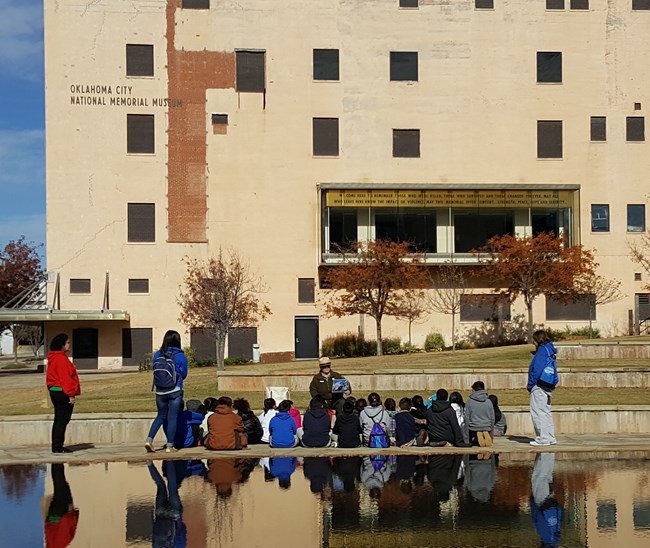
NPS Photo Resources For EducatorsThe National Park Service has been called Americas Largest Classroom and has thousands of resources available to bring into yours!The Educators subject page provides educators with downloadable lesson plans, student activities, and information on distance learning opportunities with national park sites across the United States. NPS rangers in Oklahoma City also offer a Ranger in the Classroom program, providing you and your students the opportunity to interact with a National Park Ranger and receive a curriculum-based educational program intended to help you meet your academic standards. For more information about what the NPS in Oklahoma City offers, please contact Park Ranger Matt Whitney at 405-520-1683, or by email at e-mail us. 
NPS Photo Oklahoma City National Memorial's Teacher Page.The strength, courage and resiliency demonstrated by Oklahomans and Americans in response to the Oklahoma City bombing on April 19, 1995 is an important lesson to pass on to future generations. Visiting the Oklahoma City National Memorial Outdoor Symbolic Memorial and Museum assists learners in making a deeper connection to this event. Multiple ways to experience the Oklahoma City National Memorial are available.

Every Kid OutdoorsThe Every Kid Outdoors (EKO) program brings 4th grade students in Oklahoma to the OKC Memorial & Museum, followed by a park ranger visit to their school or classroom. It is funded by a grant from the National Park Foundation. For more information, contact Park Ranger Matt Whitney at 405-609-8860, or by email.
Traveling Trunks & Ranger in the ClassroomThe Traveling Trunk program and Ranger in the Classroom are services offered free of charge to local Oklahoma schools. The purpose of the program is to offer curriculum-based educational programs that utilize NPS resources and introduce students and teachers to the NPS. Lesson plans are provided for each of these grade ranges. Lesson plans must be followed as written to meet education standards.All About BugsKids are curious about all living things, especially insects. This lesson plan is designed to introduce kids to basic insect anatomy, as well as the role that insects play in ecosystems, and how useful they are to humans. The goal is to help kids understand how important insects are in maintaining balance in nature.Grades: K-5, 6-8, 9-12 The American Bison and the Plains IndiansImpacts of westward expansion and industrialization led to the near-extinction of the bison, which changed forever the lives of the Plains Indians. This program discusses science (biology), and social studies (history and government). The conclusion of the program traces the establishment of Yellowstone National Park to promote bison conservation.Grades: K-5, 6-8, 9-12 Clues Left Behind: Identifying Animals by Tracks and ScatJust as fingerprints and DNA can be used to determine who was at the scene of a crime, animals also leave evidence of themselves wherever they go. This program will show students how we can determine an animal who passed through an area based on their tracks and their scat. Both can give us clues about the type of animal, state of health, and what their last meal was. Such information can help us understand how changing ecosystems impact wildlife.Grades: K-5, 6-8, 9-12 Hiding in Habitat: How Animals use their Skin to Camouflage and Protect ThemselvesUsing various animal pelts students will be shown how an animal’s skin can help conceal them, and how with some animals, such as skunks, their unique coloration and ward off attacks from predators.Grades: K-5, 6-8, 9-12 Predators: Nature’s HuntersStudents will learn the difference between animals of prey and predators. Using both photographs and animal pelts, along with skulls, students will learn how to differentiate between predators and prey based on eye placement, teeth, and claws. A brief video played at the beginning of the lesson will help students visualize what they are learning.Grades: K-5 Skulls and What They Tell Us About AnimalsThis lesson helps students to distinguish between predator and prey animals by examining their skulls, especially the types of teeth of each animal, as well as eye placement in the skull.Grades: K-5 So Many Trees! How do We Tell Them Apart?This lesson introduces students to the process of photosynthesis, and imparts to them the importance of good forestry. The lesson also helps them learn how to identify different trees in their community and develop an appreciation for them.Grades: K-12 Trees and How they Help UsThis lesson introduces students to dendrochronology (the study of climate change over time using tree rings). Students will also learn how trees can teach us about the past, the role of trees in conserving soil, and in controlling the presence of carbon in the atmosphere. Finally, students learn how to identify trees based on their leaves.Grades: K-5 Monarch ButterflyAt one point the Monarch Butterfly was in danger of extinction due to the destruction of milkweed plants through deforestation and development. Over half a century ago a grassroots effort was made to determine the migration of these creatures and from that came a volunteer effort to plant and maintain milkweed plants throughout the country. This lesson teaches students about the process of metamorphosis that butterflies undergo, and helps to foster in kids an appreciation for conservation.Grades: K-5, 6-8 (The trunk contains items that are most useful for elementary age students) |
Last updated: December 30, 2025
